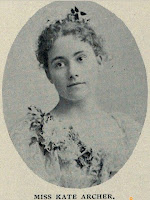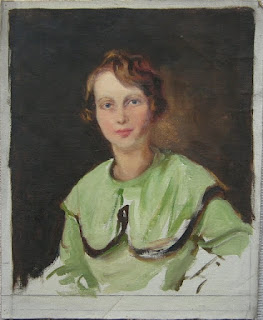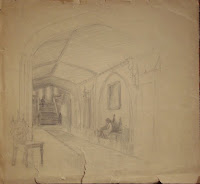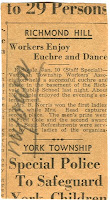We've long recognized that there must be many works of Bertha's that
were either given or sold to others during her lifetime, and probably a few more
shortly after her death, as the result of efforts by her sister, Kate. Every
once in a while we come across such a work, and it never fails to be a
thrilling moment.
It happened a short while ago, when we received a note in the
Visitor Feedback section of our web site, Bertha M Ingle - an artist to celebrate. Our visitor tells us that she purchased a lovely oil painting by
Bertha last year, at a small local auction in Chilliwack, British Columbia. It
depicts a woman holding a violin, something that is unique as far as we know in
Bertha's oeuvre. The owner wonders whether we have any idea who the woman might
be.
 It's a relatively large painting, executed in oils on board of some
kind, signed Bertha M Ingle, and nicely framed. It's much taller than it is wide,
and shows the figure full length: a youngish, slender woman in a long
gown and a matching hairband. The face is not painted in sharp detail, but in a
muted manner, slightly indistinct. It may not have been intended primarily as a
portrait. The violin is held at her waist; the bow hangs vertically from her
hand. There is a tone of calm and serenity, a warm glow in the colours and the
contrasting light of foreground and background. It is a very beautiful picture.
It's a relatively large painting, executed in oils on board of some
kind, signed Bertha M Ingle, and nicely framed. It's much taller than it is wide,
and shows the figure full length: a youngish, slender woman in a long
gown and a matching hairband. The face is not painted in sharp detail, but in a
muted manner, slightly indistinct. It may not have been intended primarily as a
portrait. The violin is held at her waist; the bow hangs vertically from her
hand. There is a tone of calm and serenity, a warm glow in the colours and the
contrasting light of foreground and background. It is a very beautiful picture.
My sister guessed that the subject might have been a senior music
student at Ontario Ladies' College (OLC), perhaps at the time of her recital to
be given as part of the Commencement Exercises in June of her final year.
Bertha was teaching at OLC in 1908 - 1909 and all the years from 1922 to 1927.
The dress struck my sister as Edwardian in its fashion (an
assessment independently arrived at by the painting's owner), which would make
1909 a likely time. I felt the hairstyle looked a bit later, perhaps more
typical of the 1920s. But there is a photo of two OLC students that we believe was
sent to Bertha in about 1909 that shows similar hairstyles; and a photo from
~1908 found in the on-line Whitby Archives shows a preponderance of hairbands.
As one would expect, detailed programs were printed up for the OLC
Commencement Exercises, and some of them have survived. One from 1887 is
available on-line, scanned from a copy in the Oshawa Public Library. It gives
details of musical performances that were part of the ceremonies. We realized
that if we could find the programs for Bertha's years at OLC, we might find
names of violinists who could be candidates for the painting's subject.
I emailed a request to OLC's successor institution, Trafalgar Castle
School. The Archivist Sarah Harries-Taylor quickly responded with interest and
willingness. She was able to find Commencement programs for 1924 and 1926. The
only mention of a student violinist was in connection with the awarding of a
Preliminary Certificate (from the Ontario Conservatory of Music) to a student named
Grace Elliot, in 1924. [In searching for that name elsewhere, I found
that Pierre Trudeau's mother's maiden name was Grace Elliott, and that there is
now a Grace Elliott Trudeau Prize for excellence in musical performance, named
for her. But the OLC student in 1924 could not have been the same Grace
Elliott. By June 1924, Pierre Trudeau was nearly 5 years old and had two
siblings ...]
We still hoped to find programs from other years
Bertha was at OLC, but meanwhile, another lead captured our interest. The
Archivist also scanned and sent a page from a Commencement program dated only
'Wednesday June 19th'. Based on the names of two of the
participants (the Rev D O Crossley and Whitby School Inspector Dr John Waugh), it must be from either 1901 or 1907. It indicates a performance for solo
violin by 'Miss K. Archer, Mus Bac', who played a Canzonetta by D'Ambrosio.
Well, it was easy to find out more about Miss Archer with a little searching, because
she was a well-known performer and teacher in Toronto. Miss Kate Archer received
her Mus Bac degree at the unusually young age of 20. That would have been in
about 1895, if the 1901 Census of Canada is correct; it gives her birth date as
November 1874. She was already teaching violin and harmony at OLC and at Glen
Mawr School in Toronto by 1898, and at the same time was a well-regarded and
frequent soloist in Toronto concerts. She is listed as the violin and harmony
teacher in the OLC Biennial Calendar for 1909 - 1910 and 1910 - 1911 (which we
have from Bertha's papers, and which was published in 1909). There's little
doubt that during her year as Assistant Art Teacher at OLC in 1908 - 1909, Bertha
would have known Miss Archer.
 Might not she, then, be the subject of the painting? It's difficult
ever to be certain, of course, especially given the painting's lack of crisp
detail. There is a comparison we can make: a book that is on-line called A Musical Souvenir of Toronto (1898) includes a photo of Miss Kate Archer. We
think it could be the same person.
Might not she, then, be the subject of the painting? It's difficult
ever to be certain, of course, especially given the painting's lack of crisp
detail. There is a comparison we can make: a book that is on-line called A Musical Souvenir of Toronto (1898) includes a photo of Miss Kate Archer. We
think it could be the same person.
Archivist Sarah suggested we contact the Whitby Archives about
further programs. The Archivist there is Brian Winter, who has helped us on past occasions. He was unable
to find Commencement programs, but discovered that OLC's Vox Collegii yearbooks
always contained detailed information about the Music Department's recitals, awards, and other activities. He kindly sent us copies of the relevant pages from the
yearbooks he could find for the years of interest (1923, 1925, 1927). In none
of these, however, can we find any violinist named who might especially suit the circumstances.
Of course, a connection with OLC is a matter of speculation, and it's not the only place Bertha could have encountered a violinist. But, for now, Miss Kate Archer remains our 'best guess' as the subject of the
painting. Despite our being unable to be more certain, it is deeply satisfying
to connect with someone who has acquired such a special painting of Bertha's, and
who treasures it as much as we would ourselves. We're sincerely grateful to her
for taking the time to share it with us, and we've enjoyed immensely the
exploration of its possible origins.
















































